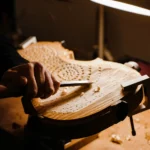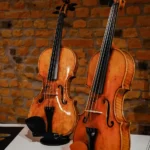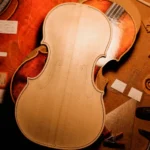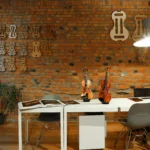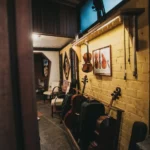Notable Sale: Violin by Lorenzo Storioni, 1774
Back to BlogLorenzo Storioni is one of the most celebrated Cremonese violin makers of the late 18th century. His instruments remain highly prized by musicians and collectors today, particularly for their exceptional tonal qualities and rich, powerful sound. This 1774 Storioni violin is a masterpiece of his craft, showcasing his unparalleled skill and artistry as a violin maker.
Violin by Lorenzo Storioni, Cremona, 1774
This Storioni violin has the most traditional Lorenzo Storioni visual, with the almost parallel F-holes slightly angled, opening towards the outside from the bottom up. The back is remarkably preserved and shows eye-catching attractive varnish wear. This violin highlights the fine, deep carved scroll and its more unfettered elongated f-holes that show off the personal interpretation of the instrument’s details. Notably, the free-handling approach promoted such a personal character imprint on this instrument.
Lorenzo Storioni (1744 – 1816) – Cremona, Italy
Inspired by “Del Gesù” legacy of a free and personal interpretation for violin making, with a strong personality imprinted in his crafting, Storioni is considered to be one of the main keepers of the Cremonese tradition throughout the end of the 1700s, together with G.B. Ceruti, his student, and the Bergonzi family’s later generations. His instruments present strong character and are recognized for their brilliant and powerful sound.
Lorenzo Storioni is by far one of the most intriguing violin makers in the Cremonese School and one of the most historically important makers of the Rococò and early classicism period. The most interesting aspect of his life and work is that despite not being linked to any nobility, sponsors, or patrons that we are aware of, his career was rather prolific, not specifically by the number of instruments that he made, but considering his relatively short career and the non-favorable times that he lived in.
Despite the decay of nobility’s wealth and power and of the Church’s role as sponsor of culture in the second half of the 18th century, the chaotic political and economic context in Europe with the erupting revolutions and social transformation, he still managed to make a considerable number of instruments, that are very much appreciated for their sound quality, even if the craftsmanship is probably not what is expected from 1700s Cremonese violin making.
Lorenzo Storioni Influences and Style
As far as it is known, he did not come from a violin-making family tradition, and therefore his learning history is unclear. Actually, he could not benefit from other makers’ teaching as there were almost no makers in Cremona at the time after Guarneri Del Gesù’s death in 1744, the year Storioni was born. Despite the probable absence of first-hand guidance, it is impossible to ignore that Storioni was born and raised in Cremona, which at the time was yet strongly linked with other important cities of violin-making history, such as Milan and Brescia. Therefore, he could have had a lot of access to the materials and information of the old masters.
Some experts claim that a viola d’amore made by Storioni, supposedly after the guidelines and diagrams that were left by Antonio Stradivari in his workshop, proves that he had access to all that treasure. This is plausible considering that Stradivari’s workshop remained closed and barely untouched from the death of his son Francesco in 1742 until 1776 when all the workshop content was purchased by the Count of Salabue.
Storioni seems to be the first great maker of Italian tradition to be more influenced by GdG than by Stradivari. Although, this influence is limited to the legacy of a free and personal interpretation of violin making, with a strong personality imprinted in his crafting. It is notable in the wide margin of variance in Storioni’s designs and forms, as can be seen in Del Gesù’s career. The elongated, often tilted f-holes, the smaller corners, and the constant change in models and finishing show that the aesthetic purpose was not as important as it was before. Storioni and GdG share the experimental personality and, as far as we can tell by studying their instruments, the focus on the acoustic results.
Coincidentally with the French domination, Storioni left Cremona in 1802 for unknown reasons and headed east, where the French front had not arrived yet. All indicates that his position in Cremona, and thus at the violin-making market, was assumed by Giovanni Battista Ceruti, who is often linked with him as a late classical Cremonese maker, but his bonds with Storioni are just as imprecise. Some evidence shows that he traveled back and forth from Cremona for a couple of years, still working as a violin maker, though there were no instruments known to be made by him at that period. After a decade or so, he returned to Cremona, where he died in 1816.
Italian Fine Violins
If you’re interested in rare and historic violins, you should definitely check fine instruments session. We have a wide selection of fine violins for sale , and it’s well worth browsing our collection to see what we have to offer. Check out our current options of fine violins, violas and cellos available for sale.





